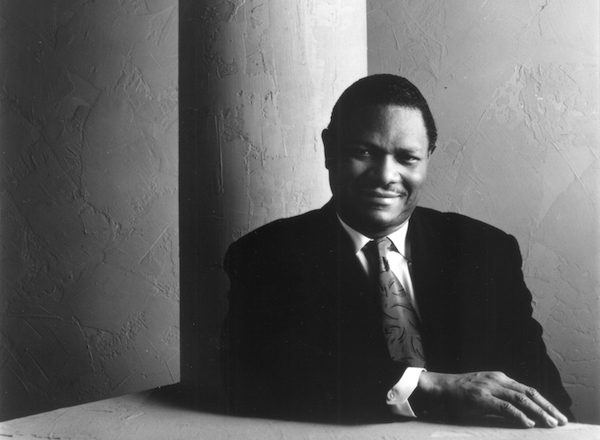Oct 28, 2025 10:47 AM
In Memoriam: Jack DeJohnette, 1942–2025
Jack DeJohnette, a bold and resourceful drummer and NEA Jazz Master who forged a unique vocabulary on the kit over his…

McCoy Tyner (1938–2020)
(Photo: Marc Norberg/Blue Note/DownBeat Archives)Tenor saxophonist Joe Lovano—who toured with Tyner in 1999 and played on the live album Quartet alongside Tyner, bassist Christian McBride and drummer Jeff “Tain” Watts—also has great reverence for the pianist. “McCoy elevated every bandstand he played on,” Lovano said. “That was spiritual music that he played, every moment. And if you were lucky enough to be in a room with him, man, he brought you to some other place.”
Guitarist John Scofield had two recorded encounters with Tyner—first on the 1989 Blue Note album Things Ain’t What They Used To Be and again on 2008’s Guitars, which had him swinging on “Mr. P.C.” and “Blues On The Corner” in the company of Tyner and the regal rhythm tandem of bassist Ron Carter and drummer Jack DeJohnette.
“I have a very distinct memory of that Guitars session,” Scofield said. “What I remember most is that I had the feeling that whatever notes I chose to play would work with what he was playing. I can’t explain it any more than that, but I felt very free. And I loved that. It wasn’t an intellectual kind of chord substitution thing that he was doing; it’s about certain voicings and moving them into other keys. But it allows you to play freely over it and then all of the sudden anything works, if you’re committed. And McCoy was certainly committed.”
“He’s certainly one of the four great modern post-bop pianists,” said tenor saxophonist Joshua Redman, who played on Tyner’s 1995 intergenerational Milestone release, Prelude And Sonata. “You can talk about McCoy and Herbie [Hancock] and Chick [Corea] and Keith [Jarrett] ... they’re kind of like the Big Four. But with McCoy, his genius is almost the most mysterious of the four. And it’s a weird thing to say because his style is also the most outwardly exuberant and physical. There’s so much visceral force in his sound and the way he attacks the piano and the drive and intention of his lines.
“So maybe introspection, mystery and interiority aren’t the first things that come to mind when you think about McCoy’s style. But for me, there’s mystery in his harmonic approach, the way he voiced chords, the lines that he played.”
In Nat Hentoff’s liner notes to Tyner’s Inception, which was recorded in 1962–’63, Coltrane assessed the pianist’s extraordinary gifts: “First there is his melodic inventiveness and along with that the clarity of his ideas. He also gets a very personal sound from his instrument. In addition, McCoy has an exceptionally well-developed sense of form, both as a soloist and accompanist. Invariably, in our group, he will take a tune and build his own structure for it. He is always looking for the most personal way of expressing himself. And finally, McCoy has taste. He can take anything, no matter how weird, and make it sound beautiful.”
A fitting epitaph for a jazz legend. DB
This story was updated March 12.

Jack DeJohnette boasted a musical resume that was as long as it was fearsome.
Oct 28, 2025 10:47 AM
Jack DeJohnette, a bold and resourceful drummer and NEA Jazz Master who forged a unique vocabulary on the kit over his…

D’Angelo achieved commercial and critical success experimenting with a fusion of jazz, funk, soul, R&B and hip-hop.
Oct 14, 2025 1:47 PM
D’Angelo, a Grammy-winning R&B and neo-soul singer, guitarist and pianist who exerted a profound influence on 21st…

Kandace Springs channeled Shirley Horn’s deliberate phrasing and sublime self-accompaniment during her set at this year’s Pittsburgh International Jazz Festival.
Sep 30, 2025 12:28 PM
Janis Burley, the Pittsburgh International Jazz Festival’s founder and artistic director, did not, as might be…

Jim McNeely’s singular body of work had a profound and lasting influence on many of today’s top jazz composers in the U.S. and in Europe.
Oct 7, 2025 3:40 PM
Pianist Jim McNeely, one of the most distinguished large ensemble jazz composers of his generation, died Sept. 26 at…

Drummond was cherished by generations of mainstream jazz listeners and bandleaders for his authoritative tonal presence, a defining quality of his style most apparent when he played his instrument unamplified.
Nov 4, 2025 11:39 AM
Ray Drummond, a first-call bassist who appeared on hundreds of albums as a sideman for some of the top names in jazz…